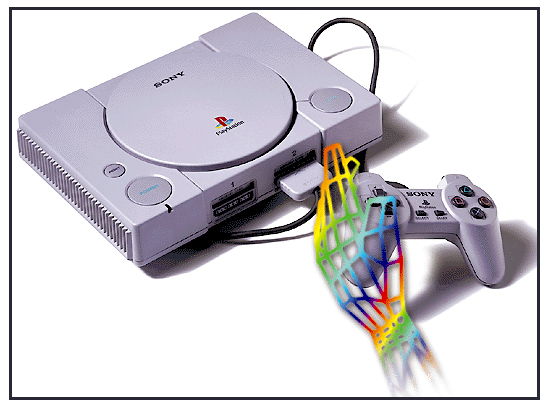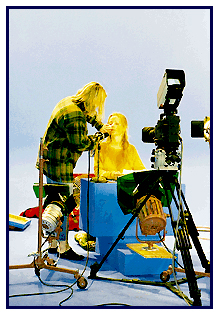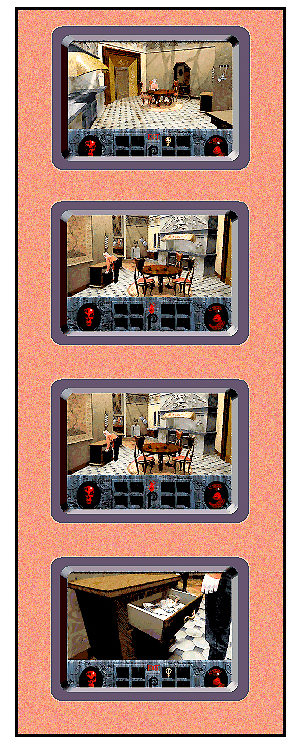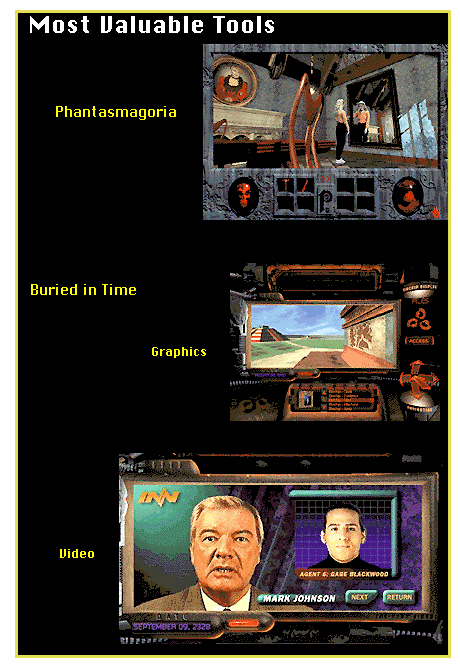| Gone are the days when a lone programmer would create a
hit game while toiling in a corner of his bedroom. Except
for a few shareware authors, the creators of commercial
games in the 1990s are teams of writers, artists,
musicians, actors, directors, videographers, and
programmers who often work with multimillion-dollar
budgets and Hollywood production values. Ironically, programmers rank relatively low in this hierarchy. Creative control rests in the hands of directors, producers, and project managers; hired talent representing numerous artistic disciplines generates content. Hot-shot programmers, once the kings of computer gaming, are indispensable for executing the final product, but they're definitely not in the director's chair. Where once a game might have been based on a clever programming trick or special effect, today's games are likely to be judged on story lines and artistic content. This is especially true of multimedia adventure games designed for mature players. Two outstanding examples: Phantasmagoria from Sierra On-Line and Buried in Time from Sanctuary Woods. While both games will entertain you with startling effects, their real strength is the way they blend traditional storytelling with interactivity in a movie-like experience. Phantasmagoria Packed onto seven CD-ROMs, Phantasmagoria might seem like the War and Peace of adventure games. But it's actually intended for relatively novice players, says project manager Mark Hood. Sierra's goal was to attract a broader audience. So the puzzles are less difficult, and the theme isn't based on science fiction. Phantasmagoria is a creepy tale of gothic horror, electrified with some truly graphic graphics. (Indeed, despite a "censor button" that tones down the game, Phantasmagoria was recently rejected by CompUSA's chain of computer stores.) Sierra began developing the game in 1993. Roberta Williams, cofounder of Sierra and author of the popular King's Quest series, wrote the original story. Phantasmagoria eventually ballooned into a $4 million project that involved about 50 people, not counting the California State University (Fresno) orchestra and choir. Most were artists; only eight to 12 were programmers. "I've seen our budgets go from 2 to 1 in favor of programming to 2 to 1 in favor of art," says Hood. Unlike most companies, Sierra doesn't write its adventure games with standard programming tools or use outside developers. Instead, in-house programmers use a proprietary tool called Sierra's Creative Interpreter (SCI) — an object-oriented language that combines elements of Lisp, Objective C, and Smalltalk. SCI is based on a procedural language that Sierra produced in-house more than seven years ago. It has two main advantages over standard tools: rapid game development and portability. Sierra programmers use the system's interactive debugger to modify their code while the game is running, which saves enormous development time. And the compiler generates p-code that executes on multiple run-time interpreters. Sierra has interpreters for DOS, Windows, and 680x0-based Macintoshes, plus another in the works for Power Macs. Interpreted code is usually slower than compiled code, but Hood says SCI delivers good performance. "The interpreter has highly optimized routines written in C++ and assembly. When the program does a `kernel call,' it directly calls those low-level routines and executes as fast as any C++ or assembly language routine. An example of a kernel call is `Play Movie' — you just make the call and tell it the number of the movie to play." Sierra's artists created most of the game's dazzling screens on a Silicon Graphics Indigo 2 workstation using SGI's Alias 3-D modeling software. They retouched the images with Adobe PhotoShop to make them appear less artificial. Videographers shot all the live video in a brand-new blue-screen studio that Sierra constructed in Oakhurst, California. It has blue-screen panels on the floors and walls, with curved surfaces wherever the panels would meet at right angles. Actors play all their parts in this studio; editors later composite their images seamlessly with the computer-generated graphics. Sierra taped all the action with broadcast-quality Betacam SP cameras. Although this may seem like overkill for video that's going to play back in a 592- by 283-pixel screen window, Hood says the quality difference is readily apparent. The raw video footage, when digitized, filled 29 CD-ROMs. About 2 hours' worth — compressed with Sierra's own proprietary software — made it into the finished game. Video editors used several tools to combine the live footage with the computer graphics. For example, whenever a person opens a door in the game, the video footage of the actor is composited with a computer-generated door. Sierra used Autodesk's Animator Pro and 3-D Studio for this frame-by-frame editing. The developers also made heavy use of a rack-mount video-compositing device called the Ultimatte. Although there's a software version of the Ultimatte that runs on a Power Mac (VideoFusion 2.0), it takes about 4 seconds to render each frame, and Sierra needed to process 72,000 frames. Hence the rack-mount Ultimatte: It works in real time. They processed additional frames with Parallax Graphics' Matador on the SGI Indigo. Composers Mark Seibert and Jay Usher wrote the music. About half was performed live by the university orchestra and choir, and the rest was created on MIDI instruments using Voyetra Technology's AudioStation software. Sierra recorded foley effects (footsteps, doors opening, etc.) in a special sound room. Later, sound editors overdubbed these effects onto the music tracks and then synchronized the sound and video using Adobe Premiere and Microsoft VidEdit. Hood is traveling to Sri Lanka to collaborate with Arthur C. Clarke on Sierra's next major project: an adventure game based on Clarke's science-fiction novel Rendezvous with Rama. Buried in Time Instead of relying heavily on video footage and composited graphics, Sanctuary Woods' Buried in Time takes a different approach. All the scenes in this science-fiction adventure game are rendered in computer-generated 3-D graphics. The few scenes that do include live-action video are there for a purpose; for example, TV news reports and videophone messages provide important clues to the main character, a time-traveling detective who works for the Temporal Security Agency. As a result, Buried in Time feels a little more interactive than Phantasmagoria. It's also designed for more-advanced players. Buried in Time is the sequel to the Journeyman Project, a hit based on the same theme. In this installment, your mission is to clear your name of false charges that you traveled back in time to alter history. Presto Studios, an independent development house in Miramar, California, created Buried in Time for Sanctuary Woods. Most games these days are developed by someone other than the distributor, and even companies like Sierra that do in-house development will often assign some miscellaneous work to outside contractors. Presto Studios began working on Buried in Time in July 1993. It was supposed to fill only one CD-ROM, but multimedia projects tend to acquire a life of their own; it ended up filling three CDs. The game eventually involved 16 developers (14 artists of various types and two programmers), 17 actors, and six testers. Before the first line of code was written, the game's authors (David Flanagan, Phil Saunders, and company president Michel Kripalani) spent months studying the historical time periods re-created in the game. Presto did all development on Macs before porting to the PC. A single programmer wrote all the code on each platform. Greg Uhler, Presto's chief financial officer, wrote the Mac version in Lingo, the scripting language in Macromind Director. Uhler also wrote the Journeyman Project, which was ported to the PC with Director. But the PC version of the Journeyman Project ran so poorly, says Kripalani, that they decided to rewrite the PC version of Buried in Time in C++. In the future, he says, they'll write both versions of new games in C++ so there's only one code base to maintain. Generating the graphics was an intensive process. The artists started with a 3-D modeling package — Form-Z from Autodesys — to create the polygon models. Then they used Adobe PhotoShop and Kai's Power Tools to create textures. They used Electric Image, a Macintosh 3-D animation package, to map the textures onto the models and generate the animation. Buried in Time is so richly detailed — about 300,000 polygons and 30 to 50 light sources per scene — that rendering each frame required 5 to 15 minutes. With 30,000 frames in the entire game, that's a lot of processing. To handle the job, Presto bought six Power Mac 8100/100s, each with 140 MB of RAM and 2-GB drives. They crunched graphics 24 hours a day. Presto shot the live video with Betacam SP and Hi-8 cameras, then used Aldus AfterEffects and Adobe Premiere for compositing. As was the case at Sierra, Presto noticed that broadcast-quality Betacam makes a big difference. Presto also discovered that some video effects couldn't be achieved even with the latest software. For example, computer-generated lightning bolts didn't look convincing, so the artists added them by rotoscoping — drawing them by hand on every video frame. Bob Stewart, an outside contractor, composed the music and overdubbed the foley effects on a Quadra 950. For sound sampling, digital audio recording, and MIDI sequencing, he used Digidesign's ProTools, OSC Media Products' DECK II, and OSC's Metro. Now that Buried in Time is finished, Presto is working on an all-new version of the Journeyman Project for the Sony PlayStation and Sega Saturn, and an action game for Apple's Pippin, a Mac-like game machine to be made by Bandai. "We're keeping busy," says Kripalani. Product Information
|



